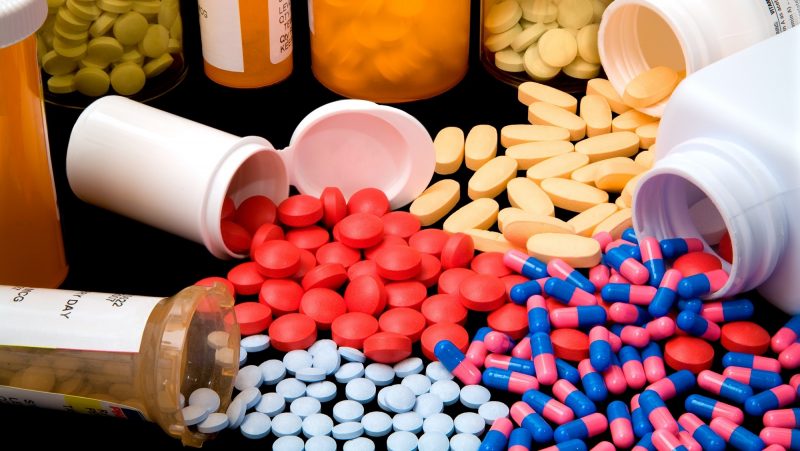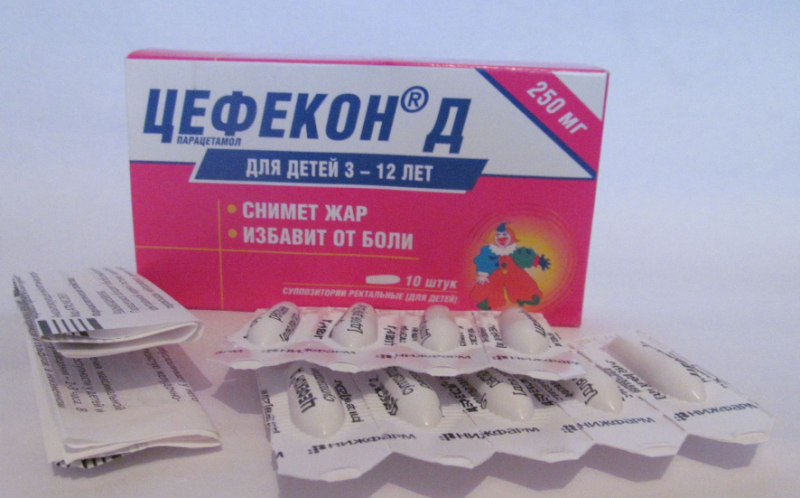Currently, suppositories are considered the safest antipyretic drugs for children. The rectal form eliminates the appearance of side effects from the stomach. Contacting directly with the rectal mucosa, the drug is absorbed faster and to a greater extent. One of these products is Paracetamol suppositories for children, a full description of which can be found below.
Material Content:
The composition of the drug
The effectiveness of the drug provides paracetamol (paraacetylaminophenol) - a non-hormonal analgesic with a mild antipyretic property. In suppositories, it is included in the amount of: 50, 100, 250 and 500 mg. The remaining mass of the candle is a solid highly refined fat, usually of synthetic origin, obtained from plant and artificial components.
Under ordinary conditions, fat is a dense uniform white mass, without foreign matter and a specific smell. It starts to melt at body temperature.
- Suppositories are formed by a cone-shaped elongated candle.
- The mass of one candle is 1.25 g.
- The drug is packaged in contour polyethylene opaque blisters of five pieces, which, in turn, are packed in cardboard boxes, which also contains instructions for use.
- The drug is stored at a temperature below 20 ° C for no more than three years.
Pharmacological action, pharmacodynamics and pharmacokinetics
Paracetamol works primarily in the central nervous system (CNS), blocking the cyclooxygenase enzyme, which is responsible for irritating the heat and pain centers. Thus, the drug lowers body temperature and has a mild analgesic effect.
In peripheral tissues, the compound is blocked by cellular enzymes, therefore, nowhere except the central nervous system, it practically does not work.
There is both a positive and a negative point in this:
- on the one hand, paracetamol cannot manifest its anti-inflammatory properties in other tissues;
- on the other, he is not able to have a negative effect on the gastrointestinal mucosa.
Prostaglandins synthesized by cyclooxygenase (COX) perform a protective function in the gastrointestinal tract. By blocking COX, paracetamol would interfere with the digestive tract. But since its action does not extend beyond the central nervous system, this does not happen.
Through the mucosa of the rectum, the compound quickly enters the systemic circulation, and then into the liver. There it goes through a cycle of conversion into inactive metabolites, some of which are toxic to the liver.
The antipyretic and analgesic effect of taking the drug increases during the first hour. After 3 to 6 hours, the concentration of the compound is halved.
Inactive forms of the compound leave the body with urine. Unchanged is no more than five percent of the drug.
In what cases are Paracetamol suppositories prescribed for children
Suppositories are prescribed to relieve two main symptoms: heat and pain.
Indications are:
- Fever with flu and respiratory infection.
- An increase in body temperature in the post-vaccination period.
- Heat provoked by childhood infections.
- Teething pain and regular toothache.
- Headache.
- Pain syndrome caused by injuries or burns.
- Muscle pain from sprains.
- Neuralgia.
A single use is permissible without a doctor's prescription. The use of the drug over three days should be justified by a specialist.
The earliest age for appointment is 3 months. After twelve years, as a rule, suppositories are not used. Children older than a month, but younger than three, you can only put suppositories once with a rise in temperature after vaccination.
Instructions for use and dosage
The method of administration of the drug is rectal. The candle is pulled out of the contour cell and inserted into the rectum. Before giving the medicine, you need to wait for the natural cleansing of the intestine or put an enema.
The effective dose of the compound is calculated based on the age and weight of the child. On average, 10 to 12 mg of active substance should fall per 1 kg of mass. The upper daily dose threshold is limited to 60 mg per kilogram.
Each next candle can be placed no earlier than four hours later. In general, up to four doses of the drug are allowed per day.
50 mg
The medicine in the minimum dosage is used in infants aged one to three months. With a single candle, they lower the temperature once or suppress pain. More than once a day, paracetamol should not be given to infants.
At the time of treatment, the weight of the child should be at least 4 kg. Babies older than three months with a mass of more than six kg need a different dosage.
100 mg
A dosage of 0.1 g is suitable for children aged three months to three years. The weight of the child should be at least 7 and not more than 16 kg. For babies weighing up to 10 kg, one candle is administered. With a weight of more than 11 kg, 1 - 2 children's suppositories with paracetamol can be administered depending on the state of health of the small patient.
250 mg
Suppositories with a quarter gram of paracetamol are prescribed after three years. The maximum age at which the use of such a medication is relevant is limited to ten years. The weight of the child should exceed 17 kg, but be no more than 30 kg.
To obtain a therapeutic effect, it is enough to introduce 250 mg paracetamol suppositories in the amount of one suppository.
500 mg
From the age of ten, when the child's weight reaches 31 kg, you can switch to oral forms of medication. But if the patient, due to the severity of the condition or due to contraindications from the gastrointestinal tract, is not able to take a pill or suspension, he can be given an antipyretic drug rectally. The dose for such a patient will be 0.5 g, which is equivalent to two suppositories of 0.25 g or one with an active substance content of five hundred mg.
Drug interaction
The drug in question is incompatible with drugs that stimulate the oxidation processes in the liver parenchyma. Examples of such agents are: tricyclic antidepressants, ethanol-containing drugs, barbiturates, phenytoin, phenylbutazone, rifampicin, flumecinol. The combined action of paracetamol with any of these agents can lead to severe poisoning by oxidation products.
Medicines that are among the inhibitors of the biotransformation of substances coming from the outside, simultaneously taken with paracetamol, can reduce its toxic effect on the liver.
Suppositories for temperature for children should not be taken with other paracetamol-containing drugs to avoid overdose.
The medicine can enhance the effect of anticoagulants, increasing the blood coagulation time.
Contraindications, side effects and overdose
The most important contraindication is hypersensitivity. If you are allergic to paracetamol, you need to look for alternative treatments. It is also unacceptable to use antipyretic suppositories for children under one month of age, since there is no reason to believe that such treatment will be safe for them.
Paracetamol is oxidized in the liver with the formation of toxic decomposition products. If the function of an organ is defective, it may not be able to handle the processing of toxic substances. With liver failure, the drug is prescribed with extreme caution. If necessary, long-term treatment constantly monitor the liver.
Paraacetylaminophenol lubricates the blood picture. It distorts the levels of uric acid and plasma sugar. In rare cases, with frequent use, it causes a drop in the level of hemoglobin, white blood cells and platelets in the blood. After a single injection, reactions in the form of skin itch and rash are possible.
When dosing a drug, you need to remember about its hepatotoxic effect.
An overdose is first manifested by symptoms of poisoning. On the second day, signs of liver damage appear. High-dose poisoning can lead to liver tissue necrosis and encephalopathy.
Paracetamol has a specific antidote, acetylcysteine, which must be administered in the first 12 hours after poisoning. The compound helps to restore the reserves of glutathione, a substance that protects cells from oxidation products. Timely treatment for overdose can stop further destruction of the organ.
Analogues of an antipyretic drug
There are other children's suppositories with paracetamol, available under the names:
- "Panadol";
- Efferalgan;
- "Tsefekon D".
On the package of candles "Panadol" there is a mark baby. Suppositories under this name are available in a dosage of 125 and 250 mg. They are used in children older than six months.
The dosage of Efferalgan has a greater scatter. The lowest concentration is 80 mg. A candle containing such an amount of paracetamol weighs only 1 g, which is a quarter gram less than the mass of the smallest suppository of the original drug.
- Candles "Efferalgan" in the lowest concentration are applicable from three months. For older children, there are dosages of 150 and 300 mg.
- Candles "Cefecon D" are produced on the same fat basis. As an active ingredient contain paraacetylaminophenol (paracetamol) in the amount of 50, 100 and 250 mg. They are used in the same way as the original medicine.
The maximum amount of any of these funds should not exceed four single doses per day.
Suppositories with paracetamol are considered the safest means in the fight against heat and pain for children up to a year. However, any medicine should be prescribed reasonably. Every year, more and more information appears confirming the hepatotoxicity of acetaminophen (under the name paracetamol is available in Western countries), which requires strict adherence to the dosage and not to use the drug more often than is actually necessary




















